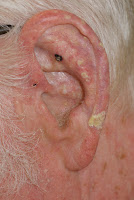As the temperature dips below zero, thoughts of travelling to the sunny south are on the minds of many Canadians. Whether it’s just for a week or for an entire season in the sun, thousands across the country make the trek to warmer climates each year.
However, before Canadians head south this winter, it’s important that they ‘tAKe notice’ of their skin! A recent survey conducted by Leger Marketing on behalf of the Canadian Skin Patient Alliance (CSPA) found that while 91 per cent of all travellers to warm and sunny destinations say sun protection is important while vacationing, most don’t always take measures to protect themselves.
Despite over-
whelmingly recognizing the importance of sun protection
and the fact that too much
sun/sun exposure is one
of the top five concerns while travelling, most don’t
always take all the steps
to protect their skin (such as wearing sunscreen, a hat or UV protective clothing). In fact, many blame their lack of protection on forgetfulness (44 per cent). What Canadians need to know is that they need to do more. That’s why the CSPA is reminding Canadians to practice proper sun safety this travel season, and educating them about skin cancer, including a relatively unknown pre-cancerous skin condition called actinic keratosis (AK).
Though most warm/sunny destination travellers have never heard specifically of actinic keratosis (87 per cent), it’s one the most common forms of skin conditions treated by dermatologists. It is strongly associated with UV exposure and sun damage. The good news is that AK can be treated, because according to some estimates, up to five per cent of actinic keratoses progress into squamous cell carcinoma, a common form of serious skin cancer that is expected to nearly triple by 2031.
What else did the survey reveal? Here’s a look: >
Getting a sunburn is a top concern for only one-in-three travellers – despite almost half saying they at least ‘sometimes’ burn
The majority of Canadians are not taking sufficient steps to protect themselves. In fact, more than half don’t always wear sunscreen (55 percent), wear a hat (78 per cent) or wear UV protective clothing (93 per cent).
Seventy-four per cent rarely or never discuss sun safety with their doctor prior to travelling.
Fifty-nine per cent would not see a physician immediately if they noticed rough spots, scaly patches suspicious spots or moles after examining their skin.
Nearly four-in-10 (38 per cent) travellers mistakenly believe actinic keratosis first appears as blisters and welts after a severe sunburn, when in fact, actinic keratosis may range in size from very small to pea-sized or larger. It can also appear as slightly red scaly spots through to thick, scaly sometimes crusty spots or patches that feel rough, sore or itchy, like sandpaper.
As Canadians get ready to take flight this winter, it’s also time for them to ‘tAKe notice’ of their skin! Remember to conduct a skin check on both yourself and loved ones, and speak with a healthcare professional if you notice anything unusual. For information about actinic keratosis,
please visit www.CanadianSkin.ca/AK




No comments:
Post a Comment
id="blogfeeds"><$BlogFeedsVertical$>
id="postfeeds"><$BlogItemFeedLinks$>